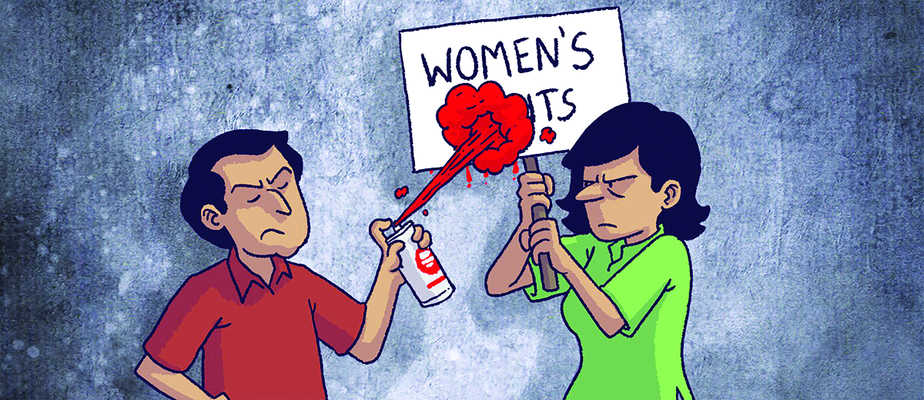Even if we dismiss the Thomson Reuters poll, research shows the relentless violence against women in India
A recent survey conducted by the Thomson Reuters Foundation said India is the world’s most dangerous country for women due to the high risk of sexual violence and being forced into slave labour. The results are based on a poll of 548 global experts on women’s issues.
The government of India not only dismissed the report by Thomson Reuters, but also called it a foreign effort to “malign the nation” and draw attention away from tangible improvements seen in recent years. The Ministry of Women and Child Development maintained that the life of the average Indian woman is far improved from a decade ago, and concluded that this is not a reflection of reality. The National Women’s Comm-ission also rejected it outright.
A tweet by Aarti Tikoo Singh, a Times Group editor, was featured in a BBC article titled “Is India really the most dangerous country for women?” following the Thomson Reuters poll result. In her tweet, Singh is questioning why the media was buying such “statistical gibberish”.
India is the world’s largest democracy, and a populous country with a rich history. On June 30, India bagged its 37th Unesco World Heritage Site tag — for Mumbai’s Victorian Gothic and Art Deco buildings. But do we really maintain the actual heritage of culture inscribed in our ancient texts? I hesitate.
Early this year, India faced massive tumult after the rape and killing of an eight-year-old in Jammu and Kashmir. It showcased a disastrous failure of the enforcement of law and order, as the accused included police officers who allegedly took Rs 4 lakh to destroy crucial evidence. As all the accused were Hindu, and the victim was Muslim, Hindu nationalists rallied in defence of the accused.
In April this year, a nine-year-old girl was found dead in Surat. The postmortem report revealed she was raped for at least eight days and had 86 injuries on her body.
On June 26 in Mandsaur, a town in the BJP-ruled state of Madhya Pradesh, a seven-year-old girl was standing outside her school, waiting for her parents to pick her up, when she was lured away by two men. They traumatised her, raped her, and slit her throat before moving away. Doctors were shocked at the victim’s injuries, and said that the incident reflected the 2012 Delhi gang-rape.
On June 27, the general manager of a 5-star hotel in Jaipur forced his way into the room of two Mexican women and allegedly molested them. On June 29, in Delhi’s Palam, a woman was allegedly thrashed and stripped while onlookers took videos on their phones, but no one came to help. In the same week as the publishing of the Thomson Reuters report, a Canadian woman was allegedly raped by a man she met at a pub in south Delhi’s Hauz Khas.
We can project India as a tourist destination, but we can’t mask its ugly face. Anyone who has witnessed or experienced this violence would not dismiss the poll results as part of a propaganda machine.
The abuse of women is dominant in our film industries too. Bollywood actor Swara Bhaskar revealed on June 30 that she was once in a meeting with the manager of a big producer and things suddenly started to get “strange”. When she tried to get out of it, the man leaned forward, tried to kiss her ear, and said: “I love you, baby”.
Bhaskar said, “That kind of stuff happens. It’s all part of the casting couch, right?”
On June 28, the Association of Malayalam Movie Artists (AMMA) in Kerala decided to reinstate actor Dileep, accused of being part of the kidnapping and sexual assault of another actor. Calling this stark misogyny, the victim and three other actors — Rima Kallingal, Remya Nambeesan, and Geetu Mohandas — resigned in protest from AMMA. Three others — Revathy, Padmapriya and Parvathy — have asked for an emergency executive meeting.
The harassment is not restricted to the common woman. External Affairs Minister Sushma Swaraj has been subjected to online hate over the last few days after her ministry transferred a passport officer for allegedly harassing an inter-faith couple and stalling their travel documents.
Following this, when she asked her followers in a Twitter poll if they approve of the abusive tweets, 43 per cent voted “Yes”.
The double standards expressed by the government with respect to the report is clear. In 2013, citing the Thomson Reuters 2011 poll, Narendra Modi tweeted: “India is considered 4th most dangerous for women. When will she feel safe & symbol of positivity?”
Now, when the 2018 poll’s country summary on India mentions Prime Minister Modi, do we see him accepting it? The report says: “Violence against women in India has caused national and international outrage and protests since the 2012 gang-rape and murder of a student on a bus in New Delhi. As India’s rape epidemic gets worse by the year, critics have pointed fingers at Prime Minister Narendra Modi’s government for not doing enough to protect women.”
The report highlights the overall risks faced by women, specifically in terms of healthcare, discrimination, cultural practices, sexual violence, non-sexual violence, and human trafficking, among others. But what we get in response is image-conscious politicians preferring to staunchly deny it.
This is the same government which believes that marital rape shouldn’t be criminalised and actively advocated for its current status as a non-criminal act.
These U-turns not only mark the hypocrisy but also expose the poor face of politics, where key issues like women safety are nothing more than an election agenda. Even if we dismiss the poll result, the harsh truth is not hidden. In truth, Indians respect only three kinds of women: Apni Mata (Own Mother), Gau Mata (Holy Cow), and Bharat Mata (Mother India). How hard we try, we can never dismiss this!
www.newslaundry.com





